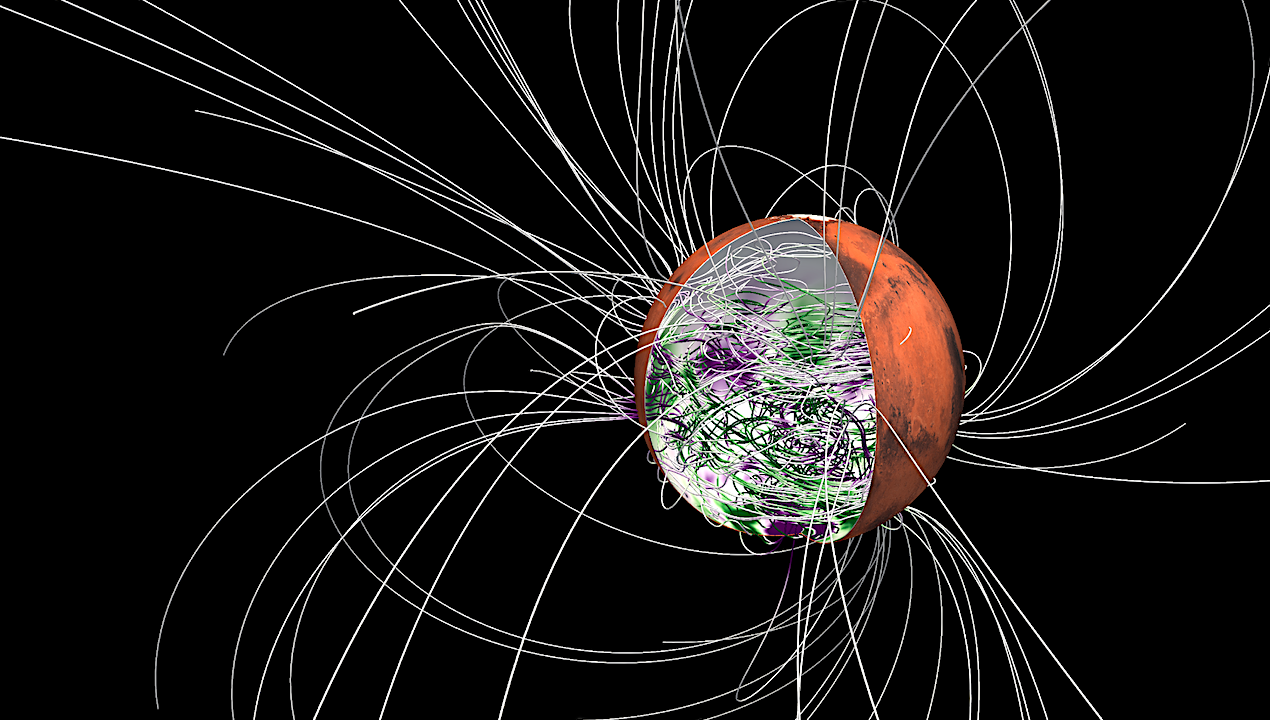Molten Martian Core Could Explain Red Planet’s Magnetic Quirks

Like Earth, Mars once had a strong magnetic field that shielded its thick atmosphere from the solar wind. But now only the magnetic imprint remains. What’s long baffled scientists, though, is why this imprint appears most strongly in the southern half of the Red Planet.
A new study from the University of Texas Institute for Geophysics (UTIG) could help explain the one-sided imprint. It presents evidence that the planet’s magnetic field covered only its southern half.
The resulting lopsided magnetic field would match the imprint we see today, said the study’s lead author Chi Yan, a UTIG research associate at the UT Jackson School of Geosciences. It would also make Mars’ magnetic field different from Earth’s, which covers the entire globe.
Yan said that the one-sided magnetic field could arise if Mars’ inner core was liquid.
“The logic here is that with no solid inner core, it’s much easier to produce hemispheric (one-sided) magnetic fields,” Yan said. “That could have implications for Mars’ ancient dynamo and possibly how long it was able to sustain an atmosphere.”
In the study, published in the journal Geophysical Research Letters, the researchers used a computer simulation to model this scenario.
Until now, most studies of early Mars had relied on magnetic field models that gave the Red Planet an Earth-like inner core that’s solid and surrounded by molten iron.
The researchers were inspired to try simulating a fully liquid core after NASA’s InSight lander found that Mars’ core was made of lighter elements than expected. That means the core’s melting temperature is different from Earth’s and therefore quite possibly molten, said study co-author Sabine Stanley, a Bloomberg Distinguished Professor at Johns Hopkins University.
If Mars’ core is molten now, it almost certainly would have been molten 4 billion years ago when Mars’ magnetic field is known to have been active, Stanley said.
To test the idea, the researchers prepared simulations of early Mars with a liquid core and ran them a dozen times on supercomputers. With each run the researchers made the planet’s northern half of the mantle a little hotter than the south.
Eventually, the temperature difference between the hotter mantle in the north and the cooler mantle in the south led to the heat escaping from the core to be released only at the southern end of the planet. Channeled in such a way, the escaping heat was sufficiently vigorous to drive a dynamo and generate a strong magnetic field focused in the southern hemisphere.
A planetary dynamo is a self-sustaining mechanism that generates a magnetic field, typically through movement in the molten metallic core.
“We had no idea if it was going to explain the magnetic field, so it’s exciting to see that we can create a (single) hemispheric magnetic field with an interior structure that matches what InSight told us Mars’ interior is like today,” Stanley said.
According to UTIG planetary researcher Doug Hemingway, the finding offers a compelling alternative theory to a common assumption that involves asteroid impacts obliterating evidence of a planet-wide magnetic field in northern hemisphere rocks.
“Mars is naturally interesting to look at because it’s like Earth in some ways and it’s the closest planet that we can imagine actually setting up shop on,” said Hemingway, who was not part of the study. “But then, it’s got this dramatic hemispheric dichotomy where the topography, the terrain and the magnetic field of the northern hemisphere and southern hemisphere are dramatically different. Anything that gives a clue at what could account for some of that asymmetry is valuable.”
The study was funded by the NASA InSight program. The simulations were conducted at the Maryland Advanced Research Computing Center.
Mars’ Hemispheric Magnetic Field From a Full-Sphere Dynamo, Geophysical Research Letters (open access)
Astrobiology








